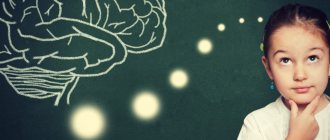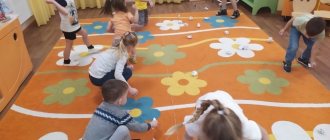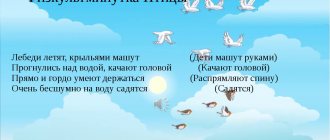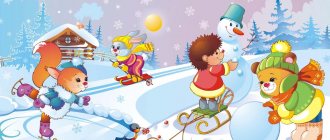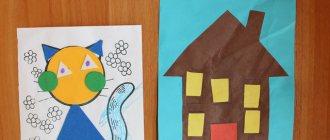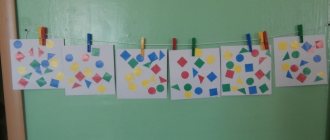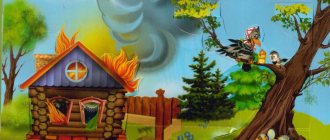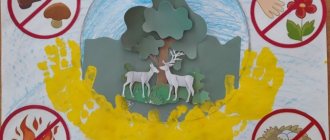Middle group. Junior preschool age. Children 4 - 5 years old
Summary of GCD for application in the middle group “Christmas tree made of triangles”
Goal: To convey the image of a Christmas tree in an application. Objectives : 1. Learn to navigate on the plane of a sheet within the silhouette image of a Christmas tree, paste ready-made shapes (triangles)
evenly filling the silhouette image; 2. Continue to teach how to make triangles by cutting...
Abstract of GCD on application with drawing elements “Herringbone” for children of primary preschool age
Application 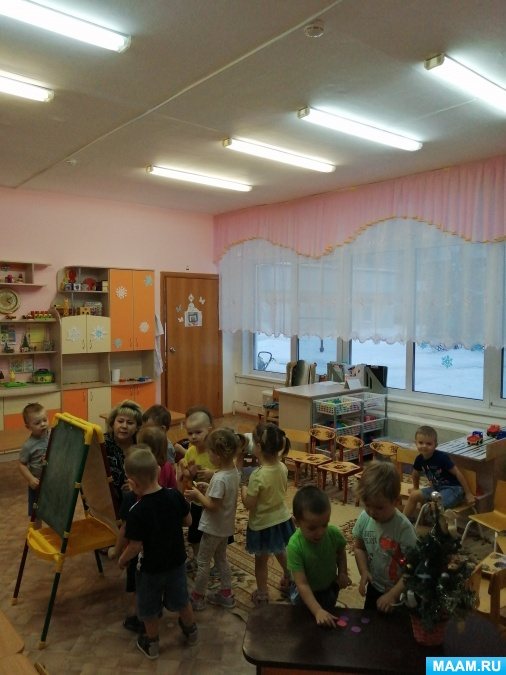
.
Work for children of primary preschool age Goal: Create a festive mood Objectives: Learn to stick ready-made shapes (circles)
Develop imagination Fine motor skills Strengthen correct sticking skills Learn to draw snow...
MAGAZINE Preschooler.RF
OOD summary on appliqué using the decoupage technique in the middle group “Chair for a Teddy Bear”Municipal preschool educational institution "Kindergarten No. 6" of the urban district of the closed administrative-territorial formation of the village. Mountain
Completed by: teacher of the first qualification category Anastasia Aleksandrovna Smorygina
2020
OOD abstract on appliqué using the decoupage
in the middle group “Chair for a bear cub”
Goal: To create favorable conditions for the development of creative abilities by decorating a rocking chair using the decoupage .
Tasks:
- Continue to form children's ideas about furniture. Strengthen the ability to place objects in accordance with the characteristics of their shape, work with glue and a brush.
- Develop imagination, creativity, aesthetic perception, activate vocabulary: nouns (names of furniture), relative adjectives (materials for making furniture).
- To cultivate love and friendliness, the desire to help one’s neighbor, and the ability to negotiate; careful attitude towards household items, respect for the work of adults; accuracy; maintain interest in joint creativity.
Material and tools:
- Paper napkins for display;
- PVA glue;
- Brushes;
- Blanks (wooden rocking chair parts)
Integration of educational areas: artistic - aesthetic, cognitive, social - communicative, speech, physical development.
Preliminary work: looking at illustrations of furniture, an excursion to the workshop of a full-service worker “Help fix the bed for Katya’s doll ,” didactic games “Which one, which one, which one?” , “The Fourth Wheel” , etc., introduction to the “decoupage” - “Plates”
Progress of OOD
1) Organizational moment (Surprise moment)
There's a knock on the door. The postman comes and brings a letter.
— Hello, is this the group “Beryozki” ? (Yes) You have a letter from a fairy forest.
B: Thank you very much (the postman leaves). Guys, let's see what's in our letter (I take out the letter and read it).
“Hello, dear guys.
Mishutka is writing to you. I had a problem, my high chair broke. Help me please"
2) Main part
Q: Poor Mishutka, what a pity for him. But what kind of Mishutka is this? Guys, do you remember in which fairy tale Mishutka’s chair broke? ( “Three Bears” ) – slide 3
What happened to Mishutka's chair? (Children's answers) - slide 4
Is it possible to swing on chairs? How should you treat furniture? (carefully, keep it clean, don’t jump, don’t drop, don’t scratch, don’t draw on it)
Q: Guys, what should we do? Who can help us? (children's answers) That's right, guys, well done. Let's call Vladimir Nikolaevich and ask him to help us. (Call V.N.)
— What materials are furniture most often made from? (Wood, metal, plastic, glass)
D/i “Which one, which one, which one?” - activate children's vocabulary. — slides 5-8
Q: Guys, what is this? (on the slide is a table), what is it made of? (made of wood), so what is it? (Wooden), etc.
Vladimir Nikolaevich arrives and brings parts of the chair.
V.N.: Guys, I’ve had parts from a chair for a long time, but I don’t know from which chair. Guys, I have to go, I still have a lot of furniture to repair.
Q: Let's see (assembling the chair). Guys, what did we do? (Rocking chair), how cool, but you can rock on such a chair and not be afraid of breaking it. But don’t you think the chair is a little dull, what are our chairs like? (beautiful and this chair needs to be decorated)
But as? (children's answers) Guys, remember we decorated the plates with pictures cut out of napkins, did you like it? Did the plates turn out beautiful? What was the name of this interesting case? (decoupage) Let's decorate this chair with napkins too. Do you agree? (Yes)
Q: — Guys, you and I have already been on an excursion to Vladimir Nikolaevich’s workshop, and he showed how he repairs furniture. I suggest you also become furniture repair experts and make a rocking chair for Mishutka.
And in order for us to get into the workshop, we need to say the magic words
Physical training “Furniture”
In the morning we will go to the workshop (walking in place)
We will invent furniture there:
Tall cabinet (stand on toes, stretch arms up)
And a stool, (squat)
Bed - we will sleep on it softly (put folded palms under the left cheek)
Let's make a chair (a bent left palm is attached to the straight right palm to make a “chair” )
And the table is big (they spread their arms to the sides)
And we’ll take everything home (turn the steering wheel)
Q: - Well, here we are in our workshop. But how will we decorate our chair, because there are many of us, but there is only one? (Take it apart, divide it) Today we will work in pairs. And we need to divide into pairs (divide into pairs).
We have 4 pieces for our rocking chair. What material are they made of? (Tree). So what are they? (Wooden) Correct. Choose one piece per pair and go to the tables.
Look, you have different pictures from napkins on your table. To begin, select those with which you will decorate your part of the chair and lay them out on the blank. Happened?
Q: Before we start, we need to review the rules for safe handling of glue and brushes (Repeat)
Now comes the fun part.
Place the picture cut from the napkin onto the surface, face up. Then carefully apply PVA glue to the napkin using a soft squirrel brush.
Spread the glue over the napkin from the middle to the edges. Smooth out all the wrinkles, being careful not to tear the napkin. Guys, we work carefully, because the napkins tear easily, and we can ruin our chair. (Work completion, individual assistance)
B: - Well, guys, we have all the details ready. Can we send them to Mishutka? (No, you need to assemble the chair) Let's assemble it. (We collect) and send it to Mishutka.
There is a knock on the door, the postman comes in: “You have a telegram from Mishutka.”
(I open the telegram, read: “Guys, how are you doing? Can you help me?” )
Q: — And we just finished assembling a rocking chair for Mishutka. please give him our parcel (We put the rocking chair in the box, hand it over to the postman. He leaves)
3) Reflection
Q: Guys, do you think Mishutka liked our chair? (It’s comfortable, beautiful, you can swing on it without breaking it).
While we are summing up, an email arrives, in it Mishutka sits on a chair and says: thank you very much for such a wonderful rocking chair!!!!!
| Next > |
Abstract of the GCD for the application in the middle group on the topic: “Bus”.
Summary of GCD for application in the middle group
on the topic: "Bus".
Tasks. Strengthen children's ability to cut out the necessary parts to create an image. Strengthen the ability to cut the corners of a rectangle, rounding them (bus body), cut the strip into identical rectangles (bus windows). Develop the ability to formulate your idea compositionally. Cultivate accuracy and independence.
I. O. O.: H.-E. R., P. R., R. R., S.-K. r., F. r.
Materials. Illustrations: urban transport. Colored rectangular paper 10*4 cm for the bus body, strips of blue paper 2*8 cm for windows, 2 black squares 2.5*2.5 cm for wheels, strips of paper of different colors for decoration. Scissors, glue, glue brush, napkin, oilcloth (for each child).
The beginning of GCD.
- Children, let's wish each other health and good mood.
Come on, children, stand in a circle! I am your friend and you are my friend.
Let's hold hands tightly and smile at each other.
— Guys, how did you get to kindergarten today? By what transport? Some of you were brought in a car, others came on foot. How great it would be if we had a bus in kindergarten! You and I could travel to nature or to the theater. Let's make a bus for the kindergarten.
Main part.
1.Looking at the illustrations.
REGIONAL COMPONENT.
— Guys, do you travel around our city by bus? And why? Yes, our town is small, so we don’t have big buses, we only have minibuses. We can see tourist buses that take tourists to Dombay, or intercity buses that deliver passengers to Stavropol, Rostov and other cities. And in big cities, people travel by different passenger transport. Guess which one:
What a miracle - a long house! There are a lot of passengers in it. Wears rubber shoes and eats gasoline (bus).
Early in the morning there was knocking and ringing and chaos outside the window. Red houses (trams) run along straight steel paths.
He is not an elk, but he has two horns, and he rides along the road with dignity. If the horns suddenly fly off
From two contact wires - The driver corrects them, And the trailer is ready to go! (Trolleybus.)
- Name the parts of the bus. (Body, windows, doors, wheels.)
— What shape does the body have?
— What shape do the windows have?
— What shape are the wheels?
2. Discussion and demonstration of ways of working.
— How can you get a circle from a square? Who can show?
- How to make squares from a rectangle? How to make a rounded top on the body of a bus?
- What should we glue first? And then?
3. Finger gymnastics.
All cars in order
They drive up to a gas station: (Turn the steering wheel in front of you with both hands).
Fuel truck, garbage truck,
A milk truck with milk,
A bread truck with fresh bread,
And a heavy timber truck. (Fingers alternately, starting with the little finger, touch the palm).
4.Independent work.
The teacher makes sure that the children hold the scissors correctly. If necessary, reminds and corrects the position of the fingers holding the scissors. Reminds you of careful gluing.
Help _________________________________________________________________
Bottom line. Exhibition of works.
- Well done boys. Look what wonderful buses you have made! Which bus do you like best? And you and I are going on a journey. Line up behind each other. Look how beautiful the bus is. So, let's go.
They sing the song “Blue Bus”.
GCD plan for plot application in the middle group “Grandma’s Garden”
Alena Yunusova
Outline of the GCD for plot application in the middle group “Grandma’s Garden”
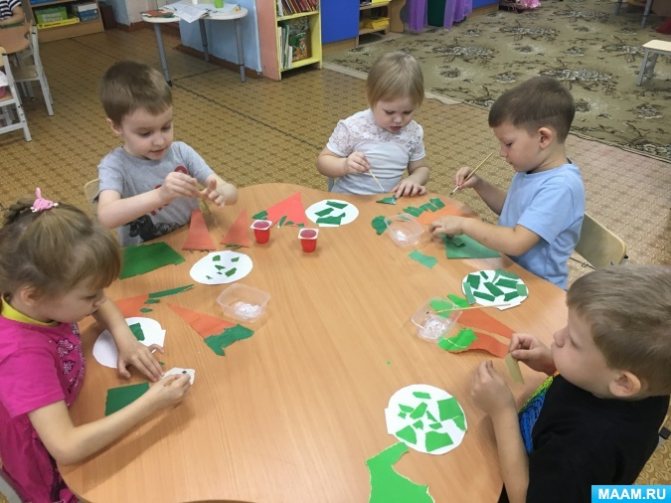
Arouse sustained interest in composing a collective composition; interest in co-creation; positive attitude towards the results of their activities.
Foster a sense of empathy and create a desire to help.
Vocabulary work: carrots, cabbage, forks, deciduous, harvest, vegetable garden .
Materials: unfinished composition “Zayushkin’s vegetable garden ”; natural vegetables (cabbage and carrots)
; orange paper rectangles for cutting out carrots, white paper ovals for depicting cabbage forks, light green crumpled paper squares for depicting cabbage leaves; scissors, glue, brushes, paper napkins.
Preliminary work: examination and examination of vegetables, conversation on the topic: “What did autumn bring us (vegetables?”), guessing riddles, didactic and n - p games, s - p game “Shop”
,
appliqué and drawing based on a presentation on the theme “The gray Bunny has become white”, construction from crumpled paper, examination of the unfinished composition “Zayushkin’s vegetable garden ”.
IOO: “Artistic and aesthetic development”
,
“Speech development”
,
“Socio-communicative development”
.
Types of activities: communicative, cognitive-research, gaming, productive, artistic creativity, reading fiction, physical education.

